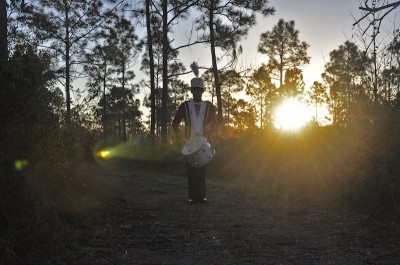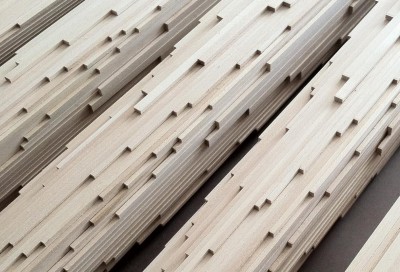
Art that beautifully exposes what we make and take from our land
It’s rare that art in a main space gallery have any real relationship with works in a project room — often, in fact, they are meant to be examples of different disciplines and different styles. And although the works of Christy Gast and Felice Grodin may not seem on the surface to have a lot in common, the amazing two-person show at Locust Projects draws an almost direct line between the conceptual background and the actual art-making of two of Miami’s most interesting artists, maybe even without intension.
When entering the new space on North Miami Avenue, you first encounter a large-screen video, which can be viewed from the front and the back, which is a continuous pan of pine forest shot in South Florida; simply gorgeous. In the main room, Gast has created a fascinating replica of sorts of an old missile hanger, being reclaimed literally by the verdant nature that thrives in our sub-tropical land.
Detail from “A Fabricated Field,” Felice Grodin.
Look up to the ceiling, which is made from pine wood (it’s original to the old building; it’s not legal to use pine anymore, as deforestation has made it so rare). Follow that ceiling to the back room, where it forms the roof of Grodin’s delicate metropolis made from a variety of woods, starting with the plywood of the floors. But are these skinny sculptures soaring upwards skyscrapers? Or bean stalks, maybe mangroves, breaking forth from a made-made barrier and rising again?
All three of these installations are a highlight of the winter season.
Gast’s video also includes, eventually, two musicians standing in the pine forest she decided to film in Monroe County: one plays Afro-Cuban conga rhythms, another plays a military snare drum. The echoes of the Cold War, of the Cuban missile crisis, points you unmistakably in the direction of the missile sculptures in the next room, made of soft textiles. They are apparently based on a real military site that was set up in the middle of the Everglades when the crisis with our Southern neighbor and the Soviet Union hit its peak. White cloth covered in green-painted depictions of tomato bushes, Brazilian pepper plants and lovegrass hang next to and over the gray missiles. The native and invasive species are taking back the terrain.
The only color in the room-size installation from Grodin is the color of the variety of woods. The spindly blond-wood stalks are often topped with darker mahogany, and they “grow” to various heights, with bases that look like exposed roots. But they also look like urban interventions, like all the high-rises that have sprouted in downtown Miami in the last decade. No surprise from the artist with an architectural degree.
We grow, and destroy, a lot of things down here.
Grodin is represented by Diana Lowenstein, and Gast shows with Diet Gallery, so cross fingers we will be able to see more creations from these talented local artists often in the future.
“Inholdings” by Christy Gast and “A Fabricated Field” by Felice Grodin open Saturday, March 8 at 7 p.m. and run through April 12 at Locust Projects, 3852 N. Miami Ave., Miami; www.locustprojects.org.
Recent Content
-
Artsarticle ·
-
Artsarticle ·
-
Artsarticle ·

